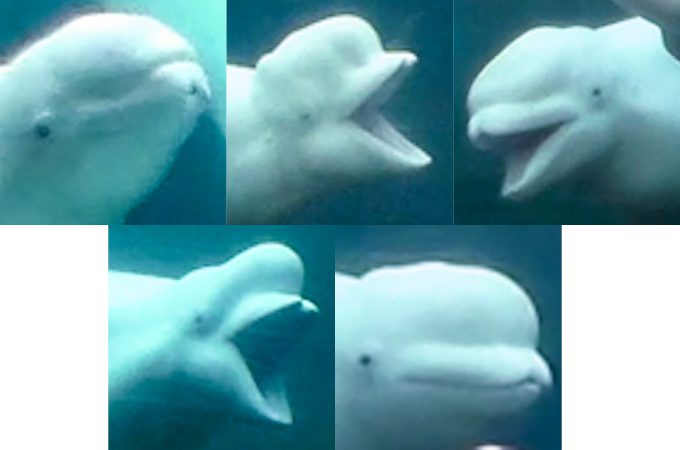The beluga whale shows its emotions through its forehead.
Researchers have made a visual reference of the various expressions that belugas (Delphinapterus leucas) in captivity appear to make with their highly movable “melon,” a soft deposit of fat on the forehead that assists in directing sound waves for echolocation.
Using muscles and connective tissue, belugas can extend the melon forward until it protrudes over their lips like the bill of a cap; flatten it against their skull; raise it vertically to create an impressive fleshy top hat; and shake it vigorously causing it to jiggle like Jell-O.
“If that doesn’t scream ‘pay attention to me,’ I don’t know what does,” says animal behaviorist Justin Richard of the University of Rhode Island in Kingston. “It’s like watching a peacock spread their feathers.”

Before Richard became a scientist, he spent a decade as a beluga trainer at the Mystic Aquarium in Connecticut, working closely with the enigmatic animals. “Even as a trainer, I knew the shapes meant something,” Richard says. “But nobody had been able to put together enough observations to make sense of it.”
Over the course of a year, from 2014 to 2015, Richard and colleagues recorded interactions between four belugas at the Mystic Aquarium. Analyzing the footage revealed that the belugas make five distinct melon shapes the scientists called flat, lift, press, push and shake. The belugas displayed an average of nearly two shapes per minute during social interaction, the team reports March 2 in Animal Cognition.
It’s not clear whether the shapes are intentional gestures or unconscious reflections of the beluga’s emotional state. But 93 percent of the shapes occurred within another beluga’s line of sight, so Richard suspects they’re probably purposeful signals or communications.
Shake and press seem to be associated with courtship and sexual behavior, while others like flat have proven more difficult to interpret. “There are probably some gradations that are meaningful to them that are difficult for us to pick out,” Richard says.
The team has validated the findings in a larger captive population — 51 belugas at MarineLand Canada in Niagara Falls exhibit the same melon shapes that the Mystic whales do.
The five shapes documented in the study may be just a small part of how this Arctic cetacean uses their melon in the wild, particularly during important behaviors such as group foraging or mothers interacting with calves.
The discoveries establish a common set of words that researchers can use to understand beluga communication, according to Malin Lilley, a psychologist at Texas A&M University–Central Texas. Lilley, who studies marine mammal behavior and thinking, says that labeling the shapes is crucial for understanding belugas and it's also exciting to have words to describe the cute facial expressions she's observed in her years of beluga research.
Richard and Lilley are both excited to understand how the shapes relate to beluga vocalizations. The constant flow of whistles, chirps, squeals, and clicks from the whales has led to belugas being called “canaries of the sea.”
According to Richard, if wild belugas exhibit this type of visual display in cloudy Arctic waters, then “there must be important information that’s being transmitted.“ There has to be a reason they devote so much time to it.”



